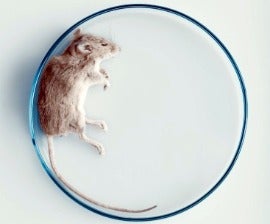-

Christina Pedrazzini/Getty Images
Home Office statistics published today on the UK’s use of animals in scientific procedures in 2016 [1] have been blasted by Humane Society International/UK as exposing the government’s failure to use its regulatory and research funding powers to curb uncontrolled breeding activities.
According to the Home Office stats, in 2016 the UK completed a shocking 3.94 million procedures on living animals, of which nearly half (49 per cent) are associated with the production of genetically altered animals, which is notorious for wasteful overbreeding. Surplus animals from continuous breeding programmes are not used for any specific testing or research purpose, but are simply bred, caged and killed without any biomedical or scientific gain. HSI is calling on the government to adopt routine cryopreservation, the freezing of sperm or embryos, to immediately curb the breeding-killing cycle and respect their commitment to reduce the use of animals in labs.
Troy Seidle, HSI senior director for research & toxicology, said: “Ultimately the best outcome for both science and animals is for our research effort to shift to cutting-edge humane alternatives, but in the meantime it’s galling to know that the number one opportunity to curb the explosive growth in UK animal procedures is being all but disregarded year after year. We’ve witnessed this trend toward out-of-control breeding of genetically modified animals developing for more than a decade, and have repeatedly called on the Home Office to take action. Yet despite all assurances of the UK government’s commitment to reducing the use of animals in labs, the numbers keep going up, rendering the government’s current strategy a qualified failure. As the department responsible for authorising animal experiments, the Home Office has all the authority it needs to require universities and other institutions to adopt more efficient strategies such as cryopreservation to minimise the over-production of genetically modified animals — all that’s missing is the motivation to act.”
Cryopreservation represents a practical, near-term alternative to continuous breeding for existing transgenic lines. The Medical Research Council’s frozen embryo and sperm archive in Harwell, and a number of animal supply companies, already offer this service [2], with facilities that can accommodate millions of cryopreserved embryos from hundreds of different strains for a small fraction of the cost of maintaining a live colony.
Facts:
- Despite the ever-increase growth in animal procedures, there is no corresponding increase in human therapeutics making it to the clinic, with both the European Medicines Agency and US Food and Drug Administration approving lowest number of new drugs in 2016 [3].
- Some genetic mutations cause catastrophic defects, such as mice born with shortened limbs, with no limbs, with the front of their head missing [4]. If the mice survive birth, they could have significant developmental defects affecting their limbs, eyes, brain or hair; they may be predisposed to tumour formation, or they could be subjected to deliberate, repeated and ultimately fatal infections to assess the impact of the mutation on their response [5].
- Advances in gene sequencing and phenotypic analysis in humans is ushering in the era of precision medicine, are may be more likely to provide the new treatments [6].
Contact: Dr Lindsay Marshall, 07719 531 675, lmarshall@hsi.org
References:
1. 2016 Home Office statistics are available here.
2. The Jackson Laboratory (2009), available here.
3. Mullard, A. (2017). EMA drug approval recommendations. Nat Rev Drug Discov. 16;77. doi:10.1038/nrd.2017.17
4. Turgeon B, Meloche S (2009). Interpreting neonatal lethal phenotypes in mouse mutants: insights into gene function and human diseases. Physiol Rev. Jan;89(1):1-26. doi: 10.1152/physrev.00040.2007
5. Holtzclaw JD, et al. (2004). Enhanced pulmonary and systemic response to endotoxin in transgenic sickle mice. AJRCCM. 169(6)2004.
6. Aronson SJ, Rehm, HL (2015). Building the foundation for genomics in precision medicine. Nature. 526: 336-342. doi:10.1038/nature15816
